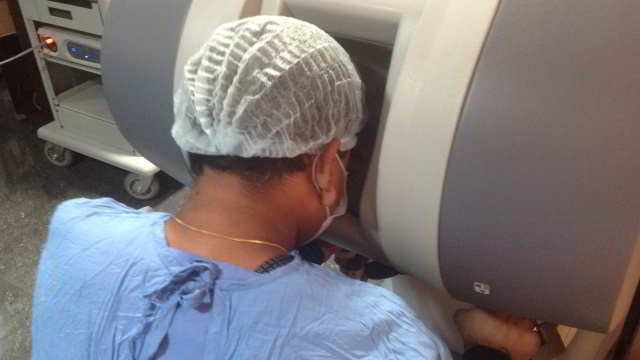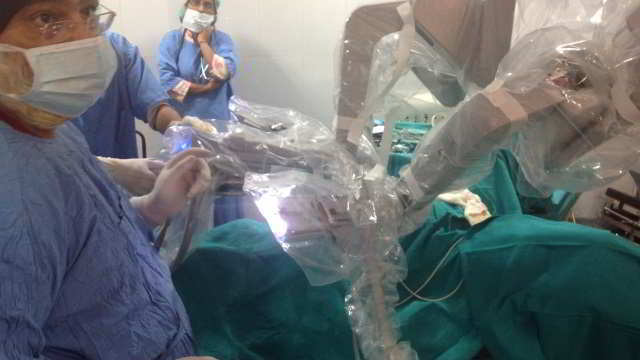da Vinci Robotic Ovarian Cystectomy
Recent advancements in minimally invasive surgical technologies mean that savvy patients have options other than conventional surgery. World Laparoscopy Hospital has invested in the newest, most precise technology - the da Vinci Robot Surgical System, a thrilling new treatment option in minimally invasive surgery for conditions including cysts on ovaries or tumors.

Ovarian Cystectomy is often a minimal access surgical excision associated with an ovarian cyst. Cysts on ovaries are small fluid-filled sacs that develop on the ovaries. Individuals with cysts on ovaries often do not experience any although some people might women may feel pressure, swelling, pain within the abdomen, pain during sex and abnormal or unusually painful periods.
da Vinci Robotic Ovarian Cystecomy is often a minimally invasive technique of those benign conditions with the ovary when a cyst can be taken off then when patient deem it desirable to depart a functional ovary available. Many of the true cysts in ladies who are still in their having reproductive years. Thus, when it is technically feasible and where the first is assured that there is no malignant tissue present, it is possible by robotic surgeon those performing pelvic surgery to try to perform ovarian cystectomy before it uses oophorectomy, specially in those patients which have children.
the da Vinci Surgical System. da Vinci allows the surgeon to operate through a few tiny incisions. Advantages include -
- Less risk of infection
- Less likelihood of negative side effects
- Less pain from surgery
- Shorter hospital stay
da Vinci is a robotic surgery system in which the surgeon controls a robot through advanced technology. Even with this advanced robotic surgical treatment for ovarian cysts and tumors, the surgeon is always in control.
da Vinci Robotic Oophorectomy, in contrast, refers back to the elimination of the ovary. This can be a minimal access robotic surgical treatment where just one or both of the ovaries are removed. Most often, an oophorectomy is completed along with a da Vinci robotic hysterectomy; however, it may be performed without a hysterectomy in the event the case dictates. Both in situations, da Vinci robotic surgery now allows us a minimal access surgical procedure for ovarian problems. Trained as a da Vinci robotics surgeon, your minimal access surgeon can use this robotic method to conduct surgery or even remove an ovary or ovaries; thereby resulting in a far better patient experience.
- Functional (follicular and corpus luteum) cysts,
- Mature cystic teratomas, and
- Endometriomas.
da Vinci Robotic Ovarian Surgery is used to confirm the diagnosis of an ovarian cyst and to remove an ovarian cyst that is causing symptoms, and rule out ovarian cancer. Minimal Access Surgery da Vinci surgery for an ovarian cyst or growth may be advised in the following situations:
- Ovarian growths are present in both ovaries.
- An ovarian cyst is larger than 10 cm.
- An ovarian cyst that is being watched does not get smaller or go away in 2 to 3 months.
- An ultrasound exam suggests that a cyst is not a simple functional cyst.
Risks of da Vinci Robotic ovarian surgery not properly done by inexperienced surgeon include the following:
- Ovarian cysts may come back after a da vinci robotic ovarian cystectomy.
- Pain may not be controlled.
- Scar tissue (adhesions) may form at the surgical site, on the ovaries or fallopian tubes, or in the pelvis.
- Infection may develop.
- The bowel or bladder may be damaged during robotic surgery.

Ovarian cysts rarely grow immense. Ultrasonography scanning permits early detection and appropriate treatment. Occasionally, ovarian cysts reach enormous dimensions without raising any symptom. Limitations of da Vinci Robotic Surgery in case of huge ovarian cyst are:
- No space to introduce the trocar
- More chance of perforation of intestine
- More chances of bleeding
- Dificult Tissue Retrieval
- Chances of Accidental rupture of Malignant Ovary
Mucinous cystadenomas of the ovary are known most commonly for their potential to grow to massive proportions and are often incidentally diagnosed. They are typically benign tumors accounting for 15% of ovarian neoplasms and up to 80% of all mucinous tumors. Management of ovarian cysts depends on the patient's age, the size and structure of the cyst, menopausal status and desire of baby. Surgical management of cysts is by laparotomic or laparoscopic or robotic cyst excision or cystectomy with oophorectomy depinding upon the experience of robotic surgeon.

A da Vinci robotic ovarian cystectomy most of the time removes only the cyst leaving the normal functional ovaries intact. However, if the ovarian cyst is too large or connected to ovarian tissue, robotic surgeon has to removes all or part of the ovary. da Vinci robotic ovarian cystectomy provide minimal access surgical exploration of the abdomen to examine the organs of the abdomen. Female suffering will be administered general anaesthesia and a single, small cut is made through the abdominal wall. Then the abdominal muscles are separated to reach ovary with the trocar site. In some cases the blood vessels supplying the ovary are clamped and tied off. Then the cyst is removed. Alternatively, samples of tissues may be removed for further analysis. If the cyst is cancerous, the surgeon may need to take out the affected ovary. The abdominal muscles are sewed and the incision is closed with stitches.
The specific complications associated with da Vinci robotic ovarian cystectomy and ovarian cyst removal in inexperienced hand include need for removal of one or both ovaries, injury to the surrounding organs, damage to the fallopian tube/s, damage to womb, and infection.
Even though a da Vinci robotic ovarian cystectomy is sometimes called 'keyhole surgery', it is still an surgical operation and therefore there is a chance that something could go wrong if the surgeon is not experienced. A common complication is injury to ovary, injury to fallopian tube and an infection that might develop at the incision sites. Another potential problem with a da Vinci robotic ovarian cystectomy is possible damage to the bladder, bowel or blood vessels from inserting the scope.
World Laparoscopy Hospital, Cyber City, DLF Phase II, Gurugram, NCR Delhi, 122 002, India
PHONES:
For Training: +919811416838
For Treatment: +919811912768
For General Enquiry: +91(0)124 - 2351555
Email: contact@laparoscopyhospital.com





